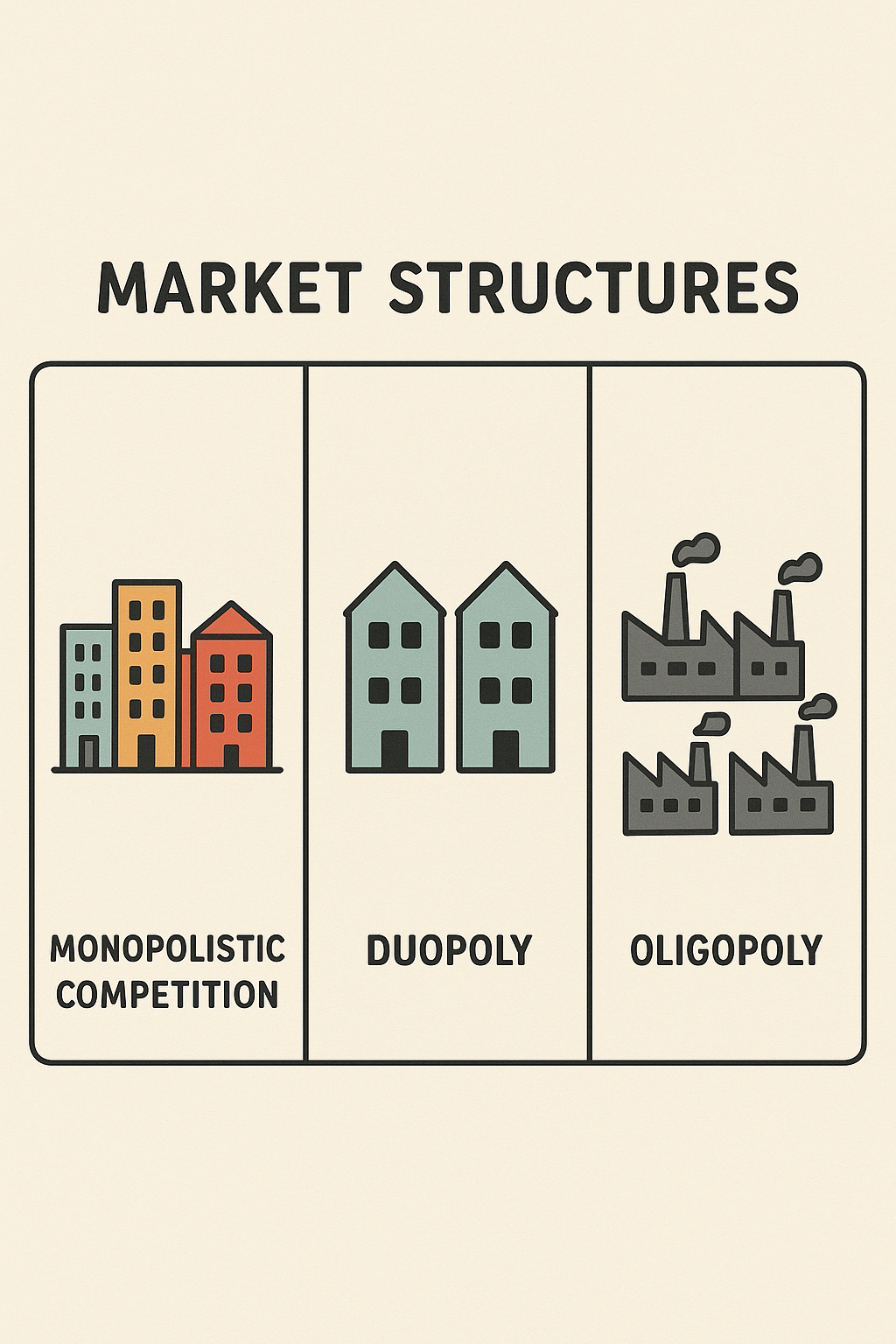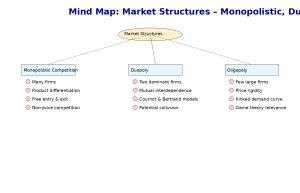
24 Jul Markets Structure : Monopolistic Competition, Duopoly, Oligopoly
Market Structures: Monopolistic Competition, Duopoly, and Oligopoly
Includes Mind Map, Infographic & UPSC Questions
Introduction
The study of market structures is crucial in understanding how firms behave, how prices are determined, and how resources are allocated in an economy. In the real world, most markets lie somewhere between the two extremes of perfect competition and monopoly. This article discusses three important forms of imperfect competition — Monopolistic Competition, Duopoly, and Oligopoly. Each market type has distinct characteristics, theoretical models, and real-world applications relevant to UPSC aspirants with Economics as their optional subject.
1. Monopolistic Competition
Definition:
Monopolistic competition refers to a market structure characterized by many firms selling similar but not identical products. Each firm has a certain degree of market power due to product differentiation.
Features:
- Large number of sellers
- Product differentiation (branding, packaging, quality)
- Free entry and exit
- Non-price competition (advertising, customer loyalty)
- Downward sloping demand curve
-
Best economics optional coaching for upsc
Short-run and Long-run Equilibrium:
In the short run, firms can earn abnormal profits or incur losses. In the long run, due to free entry and exit, firms earn only normal profits and operate with excess capacity (i.e., not at minimum average cost).
Real-life Examples:
Restaurants, clothing brands, mobile phone companies, etc., are examples of monopolistic competition.
2. Duopoly
Definition:
A duopoly is a market with only two dominant firms. Each firm’s decisions influence and are influenced by the other, leading to mutual interdependence in pricing and output.
Key Models:
- Cournot Model: Firms choose output simultaneously assuming rival’s output is fixed. Leads to equilibrium with intermediate output and price.
- Bertrand Model: Firms compete on price assuming rival’s price is fixed. Leads to prices falling to marginal cost (similar to perfect competition).
- Edgeworth Model: Focuses on price and capacity limits; no stable equilibrium.
Characteristics:
- Interdependent decision-making
- Possibility of price wars or collusion
- Higher barriers to entry than monopolistic competition
Examples:
Airbus and Boeing in aircraft manufacturing; Visa and Mastercard in the payments industry.
3. Oligopoly
Definition:
An oligopoly is a market with a few large firms controlling the majority of the market share. Firms are mutually interdependent, and competition can be based on price or non-price strategies.
Key Features:
- Few dominant firms
- High barriers to entry
- Price rigidity and sticky prices
- Use of advertising and product differentiation
- Mutual interdependence
Theoretical Tools:
- Kinked Demand Curve: Explains price rigidity. If one firm lowers price, others follow; if one raises price, others don’t.
- Game Theory: Analyzes strategic interactions using payoff matrices, Nash Equilibrium, Prisoner’s Dilemma.
Examples:
Telecom industry, automobile manufacturers, petroleum companies.
4. Infographic Summary

Market Structure forms of Market
5. Mind Map

Market Structure forms of Market
6. Key Differences Table
| Feature | Monopolistic Competition | Duopoly | Oligopoly |
|---|---|---|---|
| Number of Firms | Many | Two | Few |
| Product Type | Differentiated | Homogeneous or Differentiated | Both types |
| Price Setting | Some power | Strategic | Interdependent |
| Barriers to Entry | Low | Moderate | High |
7. UPSC Previous Year Questions
- UPSC 2022: “Compare the features of oligopoly with monopolistic competition.”
- UPSC 2020: “Discuss the importance of game theory in explaining oligopoly behaviour.”
- UPSC 2018: “Explain Cournot and Bertrand models of duopoly. What are their assumptions and outcomes?”
8. Probable Questions for Prelims & Mains
- Mains: “Analyze the kinked demand curve and its implications for price rigidity in oligopoly.”
- Mains: “Differentiate between Cournot and Bertrand duopoly models with suitable examples.”
- Prelims: “Which market form assumes product differentiation and many sellers?”
- Prelims: “The kinked demand curve is a feature of which market structure?”
9. Conclusion
Understanding these market structures equips aspirants with conceptual clarity to approach microeconomic analysis and policy applications. While monopolistic competition offers diversity and innovation, duopoly and oligopoly highlight the importance of strategic decision-making and potential inefficiencies due to market power. These topics are frequently asked in UPSC CSE Economics Optional and must be thoroughly prepared with models, diagrams, and real-world applications.




No Comments